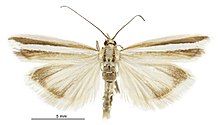Orocrambus fugitivellus
| Orocrambus fugitivellus | |
|---|---|

| |
| Male | |
| Scientific classification | |
| Domain: | Eukaryota |
| Kingdom: | Animalia |
| Phylum: | Arthropoda |
| Class: | Insecta |
| Order: | Lepidoptera |
| Family: | Crambidae |
| Genus: | Orocrambus |
| Species: | O. fugitivellus
|
| Binomial name | |
| Orocrambus fugitivellus (Hudson, 1950)
| |
| Synonyms | |
| |
Orocrambus fugitivellus is a moth in the family Crambidae. It is endemic to New Zealand. It is classified as critically endangered by the Department of Conservation.
Taxonomy
[edit]This species was first described by George Hudson in 1950 using a specimen collected by R. D. Dick in 1939 in an area adjacent to Grays River in the Mackenzie country.[2][3] Hudson named the species Crambus fugitivellus.[2] In 1975 David Edward Gaskin assigned Crambus fugitivellus to the genus Orocrambus.[4] The type specimen of O. fugitivellus is held in the Hudson collection at Museum of New Zealand Te Papa Tongarewa.[4][5]
Description
[edit]The larvae of this species have yet to be described.[6] The wingspan of the adult male is 18–19 mm.[4] In appearance the adult male of O. fuitivellus is similar to O. aethonellus but differs in the more abrupt tapering of its forewings and the very oblique termen.[2] The female of the species is brachypterous.[6]
Distribution
[edit]Orocrambus fugitivellus is endemic to New Zealand.[7][8] The Grays River wetlands in the Mackenzie Basin is the only area where this species has been recorded.[4][9] Male adults of the species have been recorded on wing in February[3][4] and are active during the day.[6]
Host plants
[edit]Although this species inhabits shrub/grasslands its host plants have yet to be discovered.[6]
Conservation status
[edit]This species has the "Nationally Critical" conservation status under the New Zealand Threat Classification System.[1][10] It has been recommended that the type locality of O. fugitivellus, the Grays River wetlands, be protected to help conserve the species.[3][11]
References
[edit]- ^ a b Hoare, R.J.B.; Dugdale, J.S.; Edwards, E.D.; Gibbs, G.W.; Patrick, B.H.; Hitchmough, R.A.; Rolfe, J.R. (2017). "Conservation status of New Zealand butterflies and moths (Lepidoptera), 2015" (PDF). New Zealand Threat Classification Series. 20: 6.
- ^ a b c Hudson, George Vernon (1950). Fragments of New Zealand entomology : a popular account of all the New Zealand cicadas : the natural history of the New Zealand glow-worm : a second supplement to The butterflies and moths of New Zealand, and notes on many other native insects. Wellington, N.Z.: Ferguson & Osborn. p. 99. OCLC 154155584.
- ^ a b c Patrick, B. H. (January 1992). "Supplement to the Lepidoptera of the Mackenzie Country with recommendations on their conservation". New Zealand Entomologist. 15 (1): 48–58. CiteSeerX 10.1.1.534.4540. doi:10.1080/00779962.1992.9722629.
- ^ a b c d e Gaskin, D. E. (1975). "Revision of the New Zealand Crambini (Lepidoptera:Pyralidae: Crambinae)". New Zealand Journal of Zoology. 2 (3): 265–363. doi:10.1080/03014223.1975.9517878.
- ^ Dugdale, J. S. (1988). "Lepidoptera - annotated catalogue, and keys to family-group taxa" (PDF). Fauna of New Zealand. 14: 148. Archived from the original (PDF) on 22 July 2019. Retrieved 1 May 2018.
- ^ a b c d Patrick, Brian; Dugdale, John S. (2000). Conservation status of the New Zealand Lepidoptera (PDF). Wellington, New Zealand: Department of Conservation. p. 28. ISBN 978-0478218671.
- ^ "Orocrambus fugitivellus (Hudson, 1950)". www.nzor.org.nz. Landcare Research New Zealand Ltd. Retrieved 2018-01-21.
- ^ Gordon, Dennis P., ed. (2010). New Zealand inventory of biodiversity: Kingdom animalia: chaetognatha, ecdysozoa, ichnofossils. Vol. 2. p. 457. ISBN 978-1-877257-93-3. OCLC 973607714. OL 25288394M. Wikidata Q45922947.
- ^ Brian H. Patrick (1992). "Supplement to the Lepidoptera of the Mackenzie County with recommendations on their conservation". New Zealand Entomologist. 12: 42–48. ISSN 0077-9962. Wikidata Q124029613.
- ^ "Orocrambus fugitivellus (Hudson, 1951)". www.landcareresearch.co.nz. Landcare Research New Zealand. Retrieved 22 January 2018.
- ^ Patrick, Brian H. (June 2004). "Conservation of New Zealand's tussock grassland moth fauna". Journal of Insect Conservation. 8 (2–3): 199–208. doi:10.1007/S10841-004-1352-1. ISSN 1366-638X. Wikidata Q60361071.

